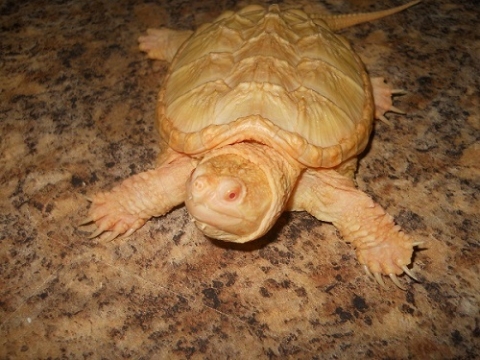Albino Common Snapper Description
Common Snapping Turtle (Chelydra serpentina serpentina)
Description:
Albino Common Snapper Common Snapping Turtles are dark brown to black in color and can be identified by their sharp beak. They can grow up to 12-15 inches long and live up to 20 years if properly cared for. Because they can be aggressive and bite, these turtles are not recommended for beginners.
Habitat and Tank Requirements:
This species is native to North America.
This species does well with a sand or gravel substrate and plenty of clean water. Water should be kept at a temperature of around 70-75 F. You will need a water filter to help maintain clean water. When choosing a filter, use common sense: a pump that is too small will leave the water dirty, while a too-powerful pump with filter out the microorganisms needed to maintain a healthy pH. Water should be deep enough that your turtle can fully submerge in it.
Adding aquatic plants will improve the water quality, the look of the habitat, and give your turtle a place to bask. Rocks or wood should also be added to give your turtle a place to rest.
If using a tank, keep a tight top on it, as these turtles are good climbers. Be sure your habitat has plenty of room for your turtle to swim around in. At least a 75 gallon or larger tank is recommended. These turtles should be kept by themselves, as they will kill smaller turtles.
These turtles do well with an ambient temperature of 75-87 F, though they are cold-tolerant. LEDs or other low-wattage light bulbs work best for maintaining these temperatures.
A basking area should be kept at about 86-90 F. You can use either a ceramic heat emitter or a reptile basking light for this. Heat rocks are not recommended as they can burn your animal.
Diet:
Common Snapping Turtles are mainly carnivorous and will feed on small crickets, mealworms, wax worms, feeder fish, pinkie or adult mice, and shrimp as well as floating turtle pellets. You can also feed them cooked lean meat, such as chicken. It is recommended that food be dusted with calcium to prevent bone softening.
Handling:
Allow your turtle time to become accustomed to its new home before handling them extensively. Handling them little by little over a period of time lets the animal get used to you and reduces stress. These turtles should not be handled by novices, as they may bite.
